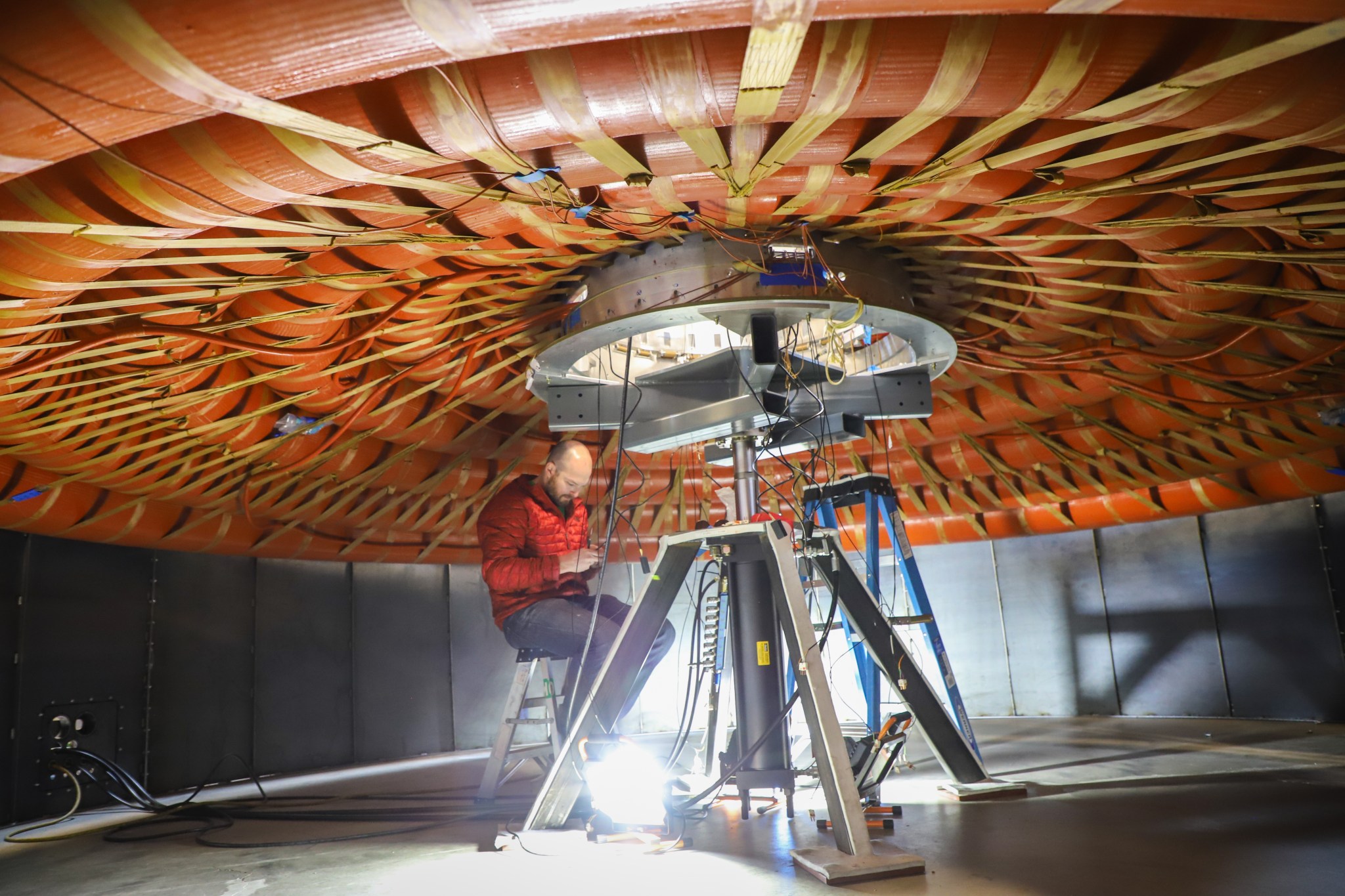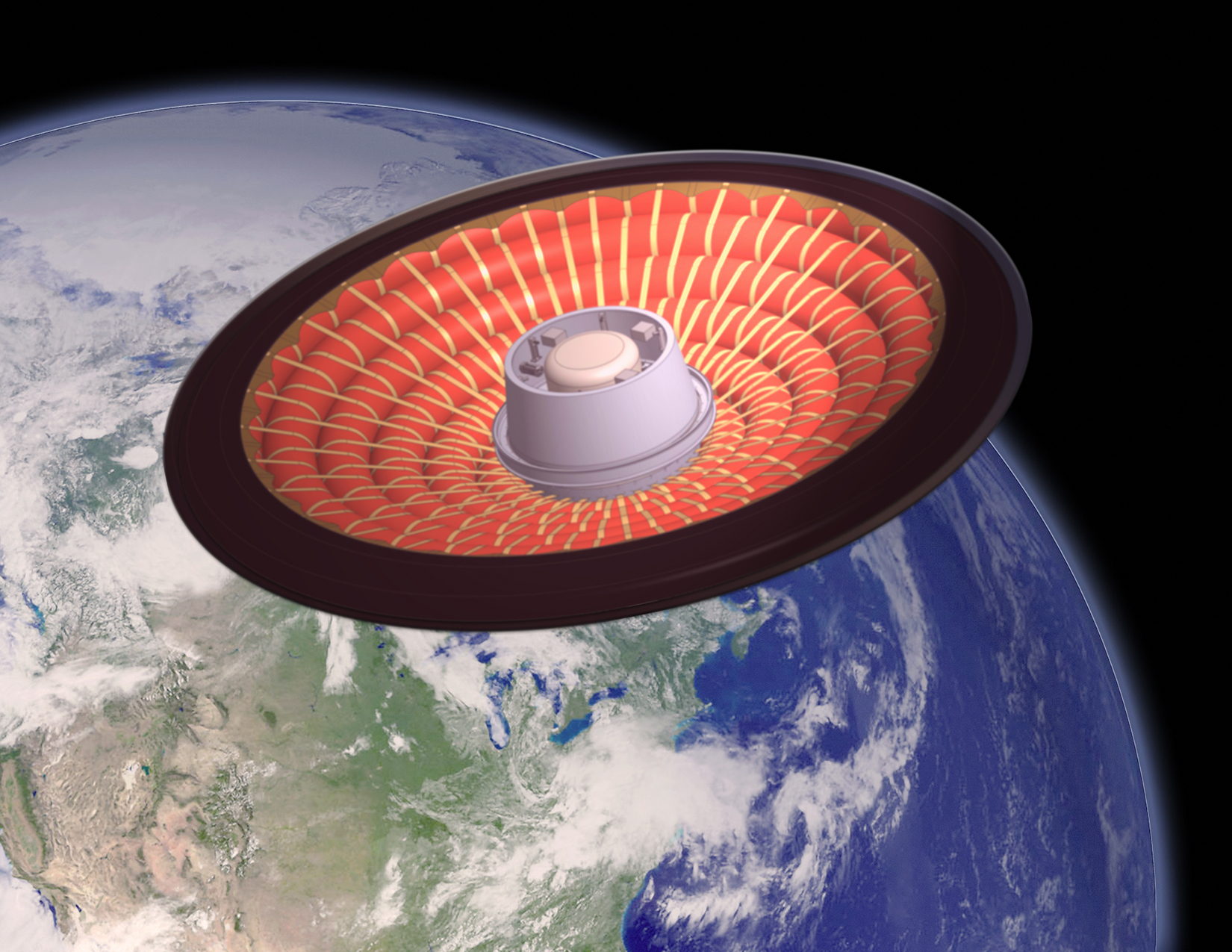Inflatable entry technology for NASA’s future missions to other worlds
Sending humans and their cargo to Mars will be an expedition unlike any NASA has attempted before. As NASA sets its sights on the Red Planet and beyond, the agency is developing technologies to ensure a safe landing for large payloads on worlds with an atmosphere. NASA’s Low-Earth Orbit Flight Test of an Inflatable Decelerator (LOFTID) mission tests a new inflatable heat shield that could enable large-scale missions to Mars, Venus, and Titan, as well as re-entering Earth’s atmosphere.
Heat shields protect spacecraft through the fiery passage of atmospheric entry, where temperatures can reach up to levels half as hot as the surface of the Sun. LOFTID’s unique approach uses an inflatable heat shield that deploys in space to slow down and shelter a spacecraft during atmospheric entry. The compact design takes up less space in the rocket than traditional rigid heat shields, allowing additional space for future large cargo needs for travel to Moon and to Mars. The scalable design has potential applications for human Mars missions, low-Earth orbit return including rocket asset recovery, and the ability to bring an unprecedented amount of mass back from the International Space Station.
Through a partnership with United Launch Alliance, LOFTID will rideshare on an Atlas V rocket with NOAA’s Joint Polar Satellite System 2 (JPSS-2). The launch is scheduled for November 2022 from Vandenberg Space Force Base in California. At launch, the packed LOFTID heat shield is only 4 feet in diameter. After deploying in space to a diameter of 20 feet, it will re-enter Earth’s atmosphere and splash down in the Pacific Ocean off the coast of Hawaii.
NASA’s Langley Research Center manages LOFTID, working with experts from various NASA centers across the country. NASA’s Ames Research Center in California’s Silicon Valley has longstanding expertise in heat shield technologies and has made several key contributions to LOFTID in the areas of instrumentation, fabrication, testing of the aeroshell, and the recovery light system.
Instrumentation
The primary goal of a flight test is to collect data on how a technology performs to help improve future versions of the technology. Instruments designed to collect that data must be able to withstand extreme environments and must be customized to fit the unique body of a deployable entry vehicle. As the lead center for LOFTID instrumentation, Ames equipped the vehicle with sensors that detect pressure, pins that measure forces, sensors that measure heat energy transfer, a radiometer, an “up-look” camera to watch launch vehicle separation and parachute deployment, and roughly 100 thermocouples that measure temperature.
This suite of instruments will give researchers a wide range of data to analyze, showing how LOFTID performed during atmospheric entry and providing insight to improve future designs. But to get this critical data, the instrumentation team needed to ensure that its devices could handle the extreme environment.
After leading investigations into sensor performance, adjustments were made in multiple areas. The Ames Sensors and Thermal Protection System (TPS) Advanced Research (STAR) Laboratories tested the radiometers and total heat flux gauges – measuring radiation and energy transfer – and used the results to improve calibration techniques, leading to better and more reliable data. Ames also designed a new configuration for the thermocouples, ensuring the sensors will withstand LOFTID’s journey.
Instrumentation contributions were also made by other NASA centers. Langley contributed the vehicle’s GPS systems and inflation system sensors. Marshall Space Flight Center provided infrared and visible camera pods as well as an inertial measurement unit, which measures accelerations and angular rates of the vehicle. Armstrong Flight Research Center provided experimental fiber optic temperature sensors.
Aeroshell Fabrication and Testing
The LOFTID aeroshell, about 20 feet in diameter once deployed, will be the largest blunt body vehicle to ever have flown and returned through Earth’s atmosphere. After this successful demonstration, the next step is to scale up to a larger vehicle that will bring NASA closer to the technology needed to eventually land humans on Mars.
Ames has a major role in TPS development for NASA missions, but this project is unique even for Ames. LOFTID uses what is known as a “flexible TPS” that has been in development at Langley for over 15 years, and Ames has supported the project for over a decade.
Building any new technology is an iterative process, and testing is a key part of iteration. Ames provided developmental testing that helped inform the design of LOFTID’s unique inflatable structure. Once the flight vehicle was created, Ames helped verify it was safe to launch and provide the data analysis needed to prove it can withstand atmospheric entry. In addition, Ames provided oversight during the manufacturing and integration process of the inflatable structure.
An earlier version of LOFTID’s technology was also tested in one of the biggest wind tunnels in the world, the 40-foot by 80-foot National Full-Scale Aerodynamics Complex (NFAC) at Ames.
Recovery Light System
LOFTID’s inflatable heat shield will splash into the Pacific Ocean under the cover of darkness, creating a unique recovery challenge for the mission. Ames provided a solution: the recovery light system, which will make it possible to visibly locate the vehicle and retrieve it at night.
The system will activate an array of lights on its parachute that flash as the vehicle descends before eventually splashing down into the Pacific Ocean. Ames led the development of the system, from its initial design and fabrication all the way through its testing and delivery.
Ames has had crucial roles in LOFTID’s success, including designs that are key to its ability to reenter safely, obtain crucial data, and recover the vehicle after the demonstration is complete.
LOFTID is dedicated to the memory of Bernard Kutter, manager of advanced programs at ULA, who passed away in August 2020 and was an advocate for technologies like LOFTID that can lower the cost of space access.
The LOFTID project is managed and funded through NASA’s Technology Demonstration Missions program, part of the agency’s Space Technology Mission Directorate. The project is led by NASA’s Langley Research Center in Hampton, Virginia, in partnership with United Launch Alliance and with contributions from NASA’s Ames Research Center in Silicon Valley, Marshall Space Flight Center in Huntsville, Alabama, and Armstrong Flight Research Center in Edwards, California. NASA’s Launch Services Program, based at the agency’s Kennedy Space Center in Florida, is responsible for managing the launch service.
Learn more
- Low-Earth Orbit Flight Test of an Inflatable Decelerator (LOFTID)
- LOFTID Fact Sheet
- NASA to Inflate Heat Shield on Earth Before Spaceflight Demo
- LOFTID Pre-Launch Media Briefing
For news media:
Members of the news media interested in covering this topic should reach out to the NASA Ames newsroom.






























